Introduction
Intelligent health applications are being developed using automation technology to help patients by providing smart health solutions. The proposed research aims to create an intelligent automated hospital infrastructure capable of performing a variety of smart tasks in an Intensive Care Unit (ICU). Using a robotic arm on an autonomous robot, the developed system will make food and medicine more accessible. Furthermore, the robotic arm can be controlled locally by the patient’s paramedics. The proposed intelligent robot will keep track of the patient’s health by automatically monitoring vital signs like sleeping, stress, and discomfort. This proposed system is especially useful for diseases like covid-19, where close proximity can spread the disease.
This study used an LSTM-based neural network to classify EEG data and compared the results to those of other machine learning algorithms. On a self-generated dataset, the proposed LSTM network achieves 94 percent accuracy. Other machine learning models such as SVM and Multilayer Perceptron are compared to the results obtained (MLP). The intelligent navigation feature is also introduced, allowing the robot to move around the ICU independently. In addition, it can set up a video conference between the patient, the staff, and the family members. In the event of an emergency, the robot can automatically notify the staff and provide assistance to the patient via an intelligent chatbot.
Methods
The proposed system consists of two modules, the first one is bed and arms control system using EEG signal classification through a state of the art LSTM deep learning architectures. Fig. 1 shows the workflow of the first module.
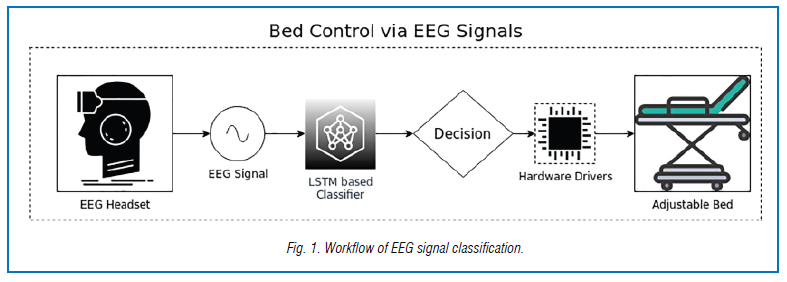
The second module is autonomous wheeled robot that can autonomously navigate the hospital and read the patients vitals through RGB camera frame using OCR and update nurses and doctors. The workflow of the second module is shown in Fig. 2. The robot has two robot arms to assist the patient in their daily life routine like drinking water, taking medicines, etc.

Three states of the art machine learning and deep learning classifier are used and evaluated on the self-generated
dataset among all LSTM network performs best. The design and implementation of three classifiers are described
below one by one.
Support Vector Machine (SVM):
Because of their high generalization potential, SVM (support vector machine) has gotten a lot of attention and has been effectively implemented to a lot of image classification tasks. These algorithms initially map non-linearly divided specimens into a higher (possibly infinite) dimensional space, then use the maximum margin research to identify a separating hyper-plane. The SVM maximizes the least length from the hyper-plane to the nearest training specimen in this higher-dimensional space.
Multilayer perceptron (MLP):
In recent decades the neural networks outperform in classification and regression problems. MLP have three types of layers. The first one is the input layer which is used to get inputs from the environment. The number of neurons in the input layer is equal to the number of features from the environment. The second type of layer is hidden layers, acting as feature extractor layers. The number of hidden layers can be more than one. The third type of layer is the output layer. The number of neurons in the output layer is equal to the number of classes.
Lonk Short Term Memory (LSTM) Network:
Recurrent Neural Networks (RNN) are neural networks that deal with sequential data to extract temporal information. The Sequential data can be textual, audio and video. LSTM produces the current output by using the previous information in the sequence. Furthermore, weights and biases for all nodes in the layer are the same. It uses the previous step’s input as well as the current input.
Results
This section gives the detailed results of SVM, MLP and LSTM classifiers. MLP and LSTM network was evaluated through Mean Square Error (MSE) and confusion matrix while SVM classifier, the hinge loss is used for evaluation. Each classifier is trained for 600 epochs and evaluated after every 50 epochs. The training and validation loss graphs of three classifiers are shown in Fig. 3.
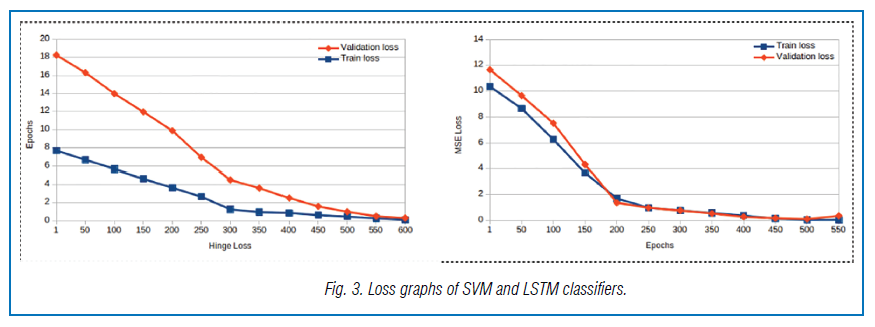
The validation loss of SVM, MLP and LSTM classifiers starts from 10.58, 11.658 and 11.658, respectively, and after
600 epochs, their losses reach 0.0965, 0.0621 and 0.0346. In Fig. 4 the training and validation accuracy graphs are
shown of three classifiers.
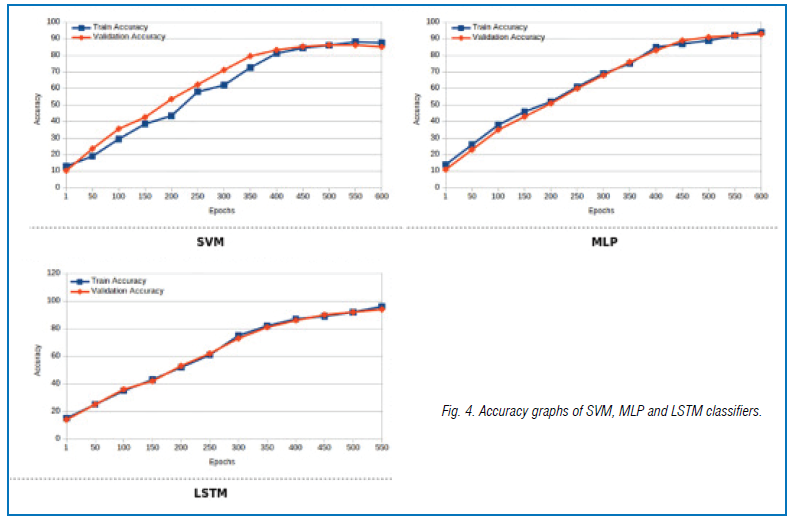
After analyzing the loss and accuracy graphs of three classifiers, it is observed that LSTM performs best among all
classifiers because of stateful feature. It remembers the previous states and used them to calculate features at time t.
The comparison graph of accuracy is shown in Fig. 5.
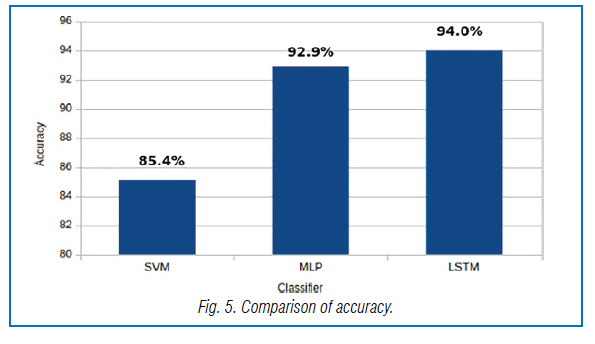
In Fig. 6 the confusion matrix of 10 classes is shown. C1 presents the first class as discussed in Section 4. The diagonal values show the number of correctly classifiedsamples out of 200 for each class. And other than diagonal values represents the number of wrongly classified samples. The 11th column of the confusion matrix shows the precision of each class, while the 11th row represents the recall of each class.
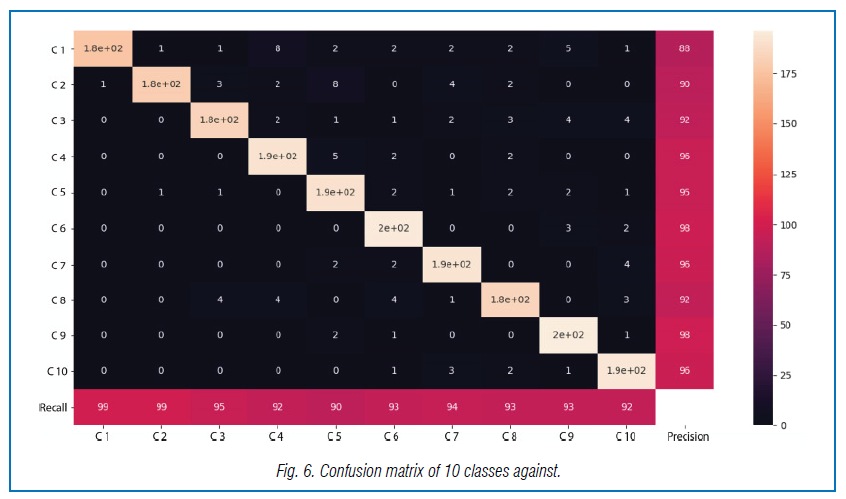
Conclusion
This research has facilitated the medical industry for diseases where close proximity can spread the disease, such as the covid-19 situation. This research work proposed an intelligent robot to assist the patients in ICU and the hospital’s rooms. It will assist the patients through the brain-computer interface (BCI) by understating the EEG signal using machine learning and deep learning algorithms.
This research compares the three state-of-the-art machine learning and deep learning algorithms and finds out LSTM performs best because it achieves 94.0% accuracy on a self-generated data-set. The intelligent navigation system is proposed to make the robot autonomous using the map, Kinect sensor, and other encoders and actuators. We Believe that it will be a valuable addition in hospitals, health care centers that can enhance the capability of modern health systems.
Source: Muhammad Asim Rehmat, Muhammad Ahmed Hassan, Mirza Haseeb Khalid, Mudasir Dilawar, Next level of hospitalisation through smart ICU, Intelligent Systems with Applications, Volume 14, 2022, 200080, ISSN 2667-3053, https://doi.org/10.1016/j.iswa.2022.200080.




